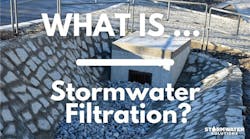Key Highlights
- Permeable pavements help reduce stormwater runoff by allowing water to pass through surfaces into underlying soil or reservoirs.
- They filter pollutants such as pesticides, oil, and fertilizers, preventing contamination of local waterways.
- Different types include pervious concrete, porous asphalt, interlocking pavers, and plastic grids, chosen based on design goals.
- Maintenance involves keeping surfaces clean, vacuum sweeping, and avoiding harsh treatments like power washing or resealing.
- Benefits include flood mitigation, groundwater recharge, improved water quality, and enhanced urban aesthetics.
Heavy rains combined with lack of absorption can lead to stormwater runoff. Runoff is caused by excess water on land that cannot be absorbed by soil. Runoff can carry pollutants from the built environment into local waterways, polluting rivers, lakes, streams and groundwater. Impervious surfaces, like roads, parking lots and buildings, prevent water from infiltrating the ground, leading to increased runoff. The development of permeable surfaces allows water to percolate through surfaces for better infiltration.
Permeable pavements consist of alternative materials including pervious asphalt, pervious concrete, interlocking pavers and plastic grid pavers. The permeable surfaces and designs allow rain and snowmelt to seep through the surface and percolate into underlying soil.
What is permeable pavement?
Permeable pavements allow stormwater runoff to percolate through surfaces into underlying soil or storage for infiltration. The composition of permeable pavements varies and include asphalt, concrete, pavers and plastics. Permeable pavement surfaces may collect runoff from impervious areas such as roofs and roads.
Permeable pavements feature a porous surface that allows water to pass through. The water that passes through the pavement collects in a layer of soil, stone or reservoir that allows the stormwater to be filtered and slowly released into the ground. The soil, stone and some reservoirs filter the water as it passes through before infiltrating into the underlying soil. Some systems feature an underdrain which discharges water if the underlying soil has a low infiltration rate.
What causes polluted runoff?
One of the main purposes of installing permeable pavements is to filter out pollutants in stormwater runoff. Pollutants can gather on nonporous surfaces in the built environment and wash out into local waterways during heavy rain events. According to the city of Saint Peter, Minnesota, examples of pollutants include:
- Excessive pesticide use
- Oil dripping from vehicles
- Pet waste
- Fertilizer
- Salt use on driveways and roads
What are the different types of permeable pavement?
Permeable pavements can be made of many different surfaces, but the most commonly used surfaces include:
- Pervious concrete
- Porous asphalt
- Permeable interlocking concrete pavers (PICP)
- Plastic and concrete grids
- Amended soils
Choosing a surface depends on the design goals. According to the Minnesota Stormwater Manual, permeable pavement can be installed with an underlying reservoir consisting of open-graded, crushed rock that provides water quality and quantity control by storing runoff and allowing it to infiltrate over an extended period of time.
How does permeable pavement work?
Traditional pavements are nonporous and contribute to stormwater runoff. Permeable pavements allow stormwater to infiltrate through the surface into underlying stone or soil. Permeable pavement systems often include the porous pavement surface, a bedding course, an open-graded aggregate base and an underdrain.
Permeable pavements use a specially designed mix of aggregate to achieve a porous yet rugged surface. While interlocking pavers may not be porous themselves, the open joints between the pavers allows water to infiltrate into the underlying surface.
Beneath the permeable pavement sits a layer of stone which offers some filtration and provides a level surface for the installation of the pavement. Permeable pavement systems often include an aggregate base or reservoir made up of larger stones. According to Fairfax County, Virginia, the aggregate base layer provides temporary storage for infiltrated water and structural support for the surface and filters pollutants from runoff.
How do you maintain permeable pavement?
Fairfax County Public Works also lists ways to maintain permeable pavement, including:
- Keep pavement surfaces clean and free of debris
- Vacuum sweep the area on a scheduled basis
- Routine maintenance and checks for things like cracks, slumps or broken pavers
- Avoid sanding, resealing, resurfacing and power washing
What are the benefits of permeable pavement?
The main purpose of permeable pavements is to reduce stormwater runoff and pollutants that may wash into local waterways. The porous pavements have other benefits as well including:
- Localizes flooding and erosion
- Replenishes groundwater and improves water quality
- Improved site appearance
- Reduced land needed for stormwater management
- Satisfies requirements for green space
What are examples of permeable pavements?
Chicago’s Green Alley program assessed the Illinois city’s 1,900 miles of alleyways and concluded that they compose approximately 3,500 acres of impermeable surfaces. Many alleys in the city are prone to flooding due to a lack of connections to the combined sewer and stormwater system. The city weighed installing connections versus more sustainable solutions.
The city began pilot applications by installing permeable pavements in alleyways. The city studied the potential benefits of green alleys across which included:
- Up to 80% of rainwater could pass through permeable pavement in the green alleys
- Permeable pavements with a light, reflective surface could reflect heat energy, cutting down on the urban heat island effect
- Using recycled materials for permeable pavements could reduce waste to landfills
Similarly, in 2012, Provincetown Harbor, Massachusetts, undertook a project to transform a downtown commercial area with porous pavement. Local beaches would experience high fecal coliform bacteria levels due to stormwater runoff. Porous pavement was installed on Commercial Street, the heart of the downtown commercial area. According to sampling collected by the Barnstable County Department of Health and Environment and the town of Provincetown’s Health and Environmental Affair’s Department, data indicates that the porous pavement installation contributed to a reduction in beach closures.
About the Author
Alex Cossin
Associate Editor
Alex Cossin is the associate editor for Waterworld Magazine, Wastewater Digest and Stormwater Solutions, which compose the Endeavor Business Media Water Group. Cossin graduated from Kent State University in 2018 with a Bachelor of Science in Journalism. Cossin can be reached at [email protected].




